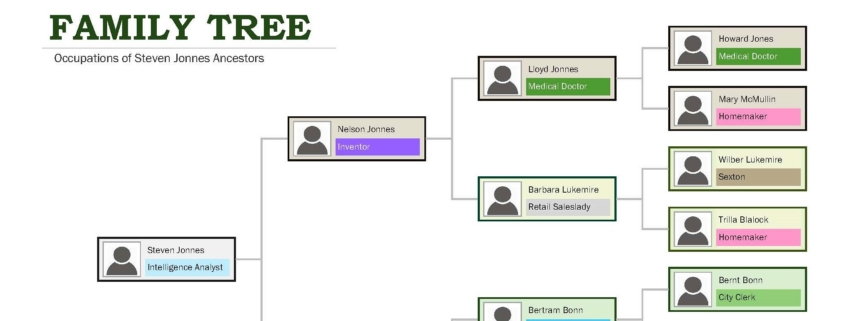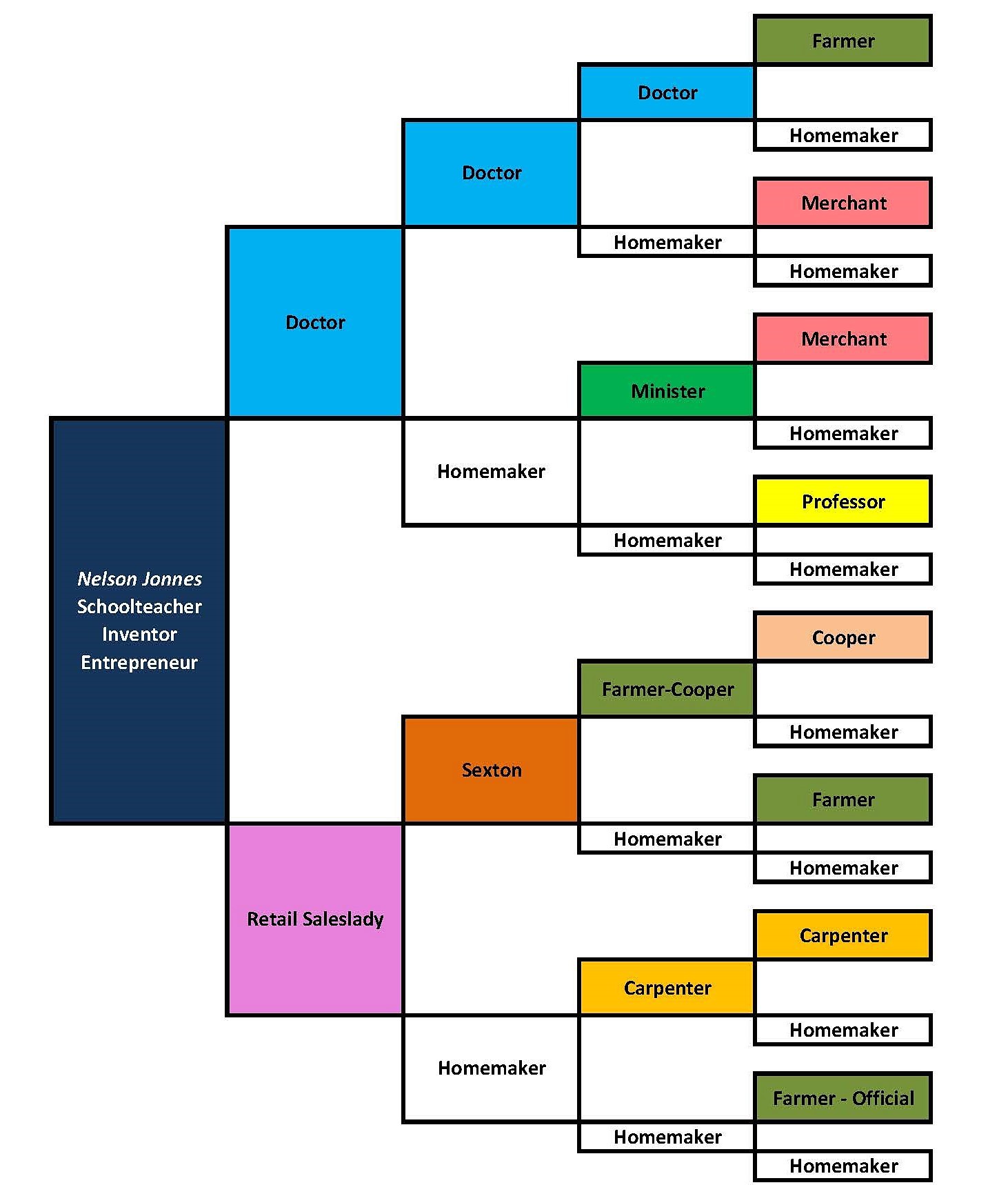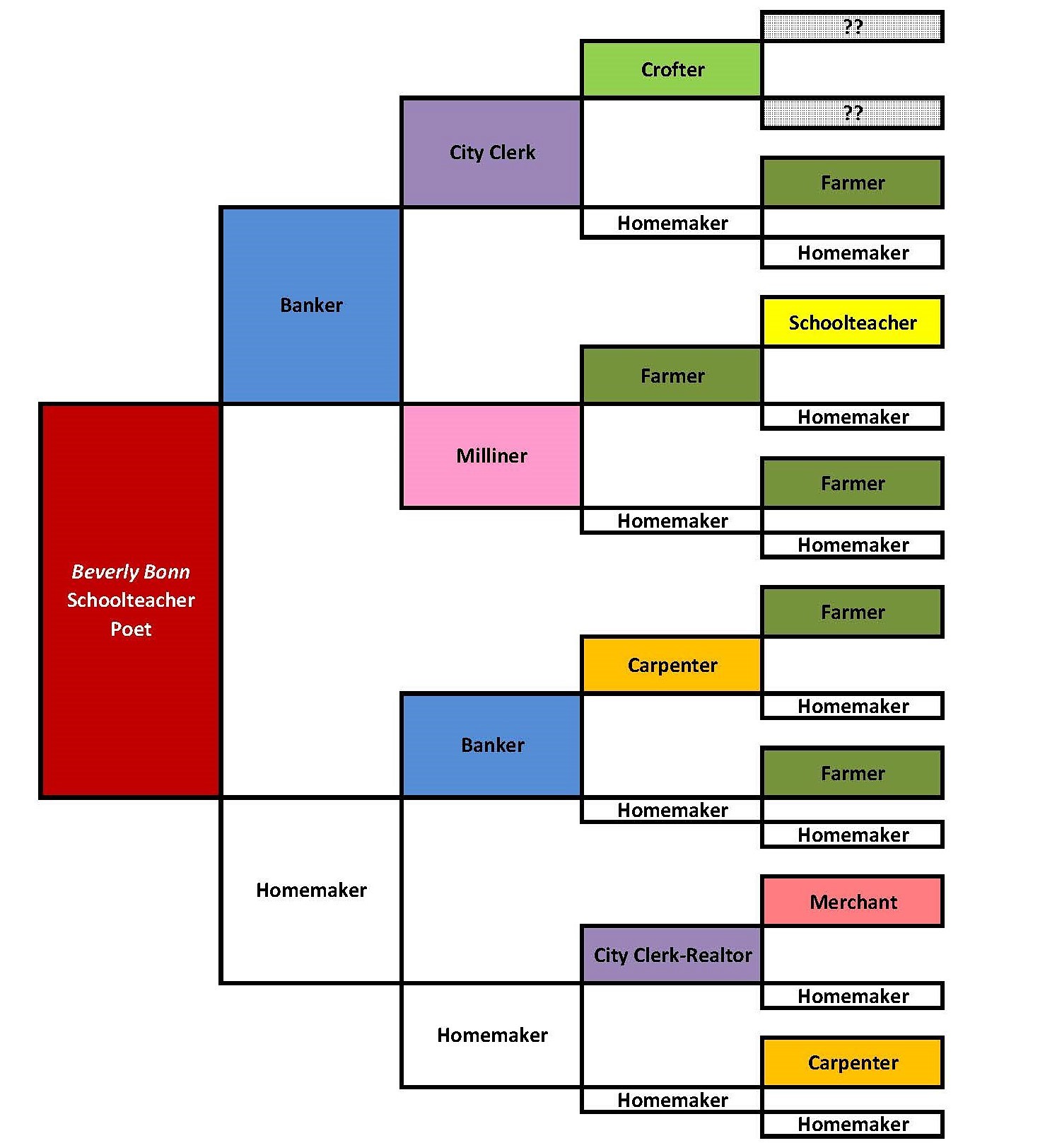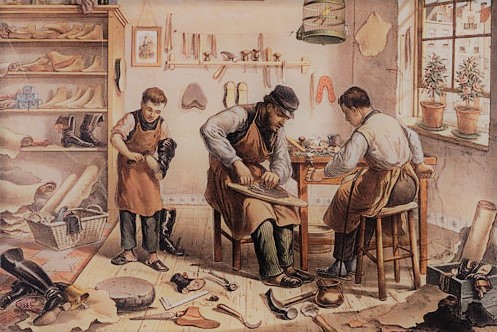Ancestors by Occupation I
Family trees come in all forms and styles. In addition to the traditional chart that identifies ancestors by name, one can also create tree diagrams emphasizing a particular aspect or feature of one’s ancestors. Genetic trees, for example, are popular because they identify the ancestors from whom you actually receive DNA, based on the fact that we do not receive DNA from all our direct ancestors, especially past the 3GG generation. Other tree diagrams show ancestors by birthplace or religion.
But today I want to introduce my ancestors by occupation. Keep in mind we’re only including direct, not collateral ancestors – no cousins, uncles, aunts, etc.
Let’s start by listing the occupations of my recent direct ancestors going back five generations. (The reference to crofter indicates a Norwegian ancestor who was similar to a tenant farmer. The Norwegian word is husmann.)
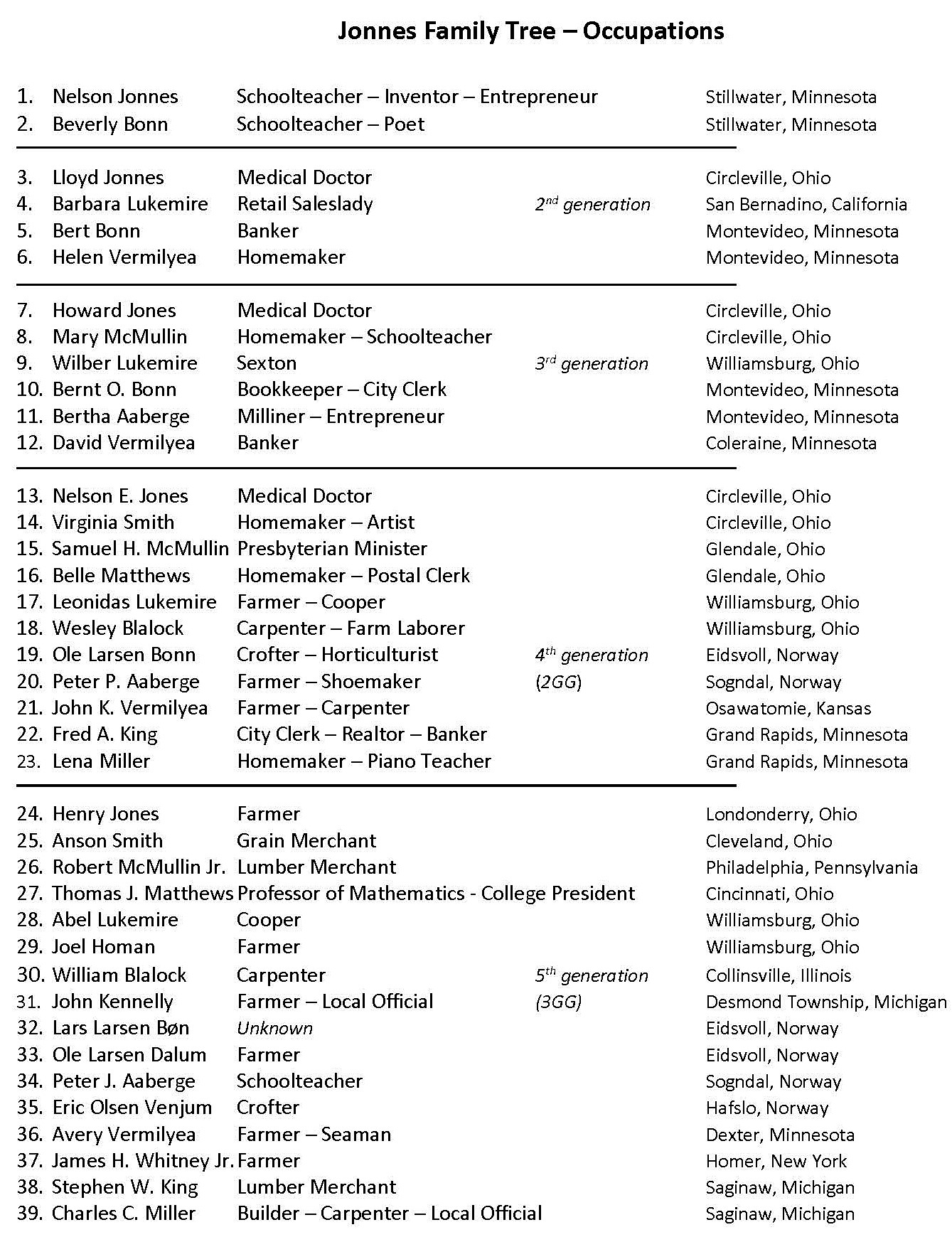
Jonnes Ancestry by Occupation (Created 2022 by author)
I’ve simplified the list in those situations where an ancestor had multiple occupations. My father, for example, started out as a chemistry schoolteacher, but also became an insurance and mutual fund salesman, then a chemical lab technician, lab manager, and finally an entrepreneur and inventor. He even worked as a toy developer at Fisher-Price for one year.
Having multiple occupations is more common in recent times. However, there are previous ancestors who also had complicated work histories. 2GG John Knickerbocker Vermilyea (1851-1925), for example, is listed as a farmer and carpenter. His resume has one additional layer, however. He initially owned and operated a hardware store and drugstore in Dexter, Minnesota with two brothers. But those ventures failed and he turned to farming. In his early 50s, he moved to Ossawatomie, Kansas and became a house carpenter.
3GG Prof. Thomas Johnson Matthews (1788-1852) is an even better example. He was a schoolteacher, surveyor, literary magazine editor, insurance company executive, math professor, astronomer, school president, and public education activist.

Prof. Thomas Johnson Matthews (1788-1852)
Prior to 100 years ago, breadwinners were almost exclusively male, so this analysis obviously concentrates on them. There was a typical division of labor in traditional times, reflecting an inside/outside-of-house demarcation. Males provided the food for cooking and materials for clothing and maintained the shelter, while females prepared the food and clothing, cleaned the shelter, and took the lead in child-rearing and cultural education.
My female ancestors who are known to have worked or who are known for some side activity include the following:
- Mother Beverly (Bonn) Jonnes (1932-2019), 5th/6th grade schoolteacher and poet
- Grandmother Barbara (Lukemire) Jonnes (1899-1974), department store saleswoman and manager
- Great grandmother Bertha (Aaberge) Bonn (1865-1936), milliner and businesswoman
- Great grandmother Mary (McMullin) Jones (1858-1952), schoolteacher for 2 or 3 years before marriage
- 2GG Virginia (Smith) Jones (1827-1906), became lithographic artist in her 50s
- 2GG Belle (Matthews) McMullin (1836-1921), postal clerk after husband’s death, then matron at home for elderly women
- 2GG Lena (Miller) King (1860-1932), piano teacher
- 3GG Berthe (Vikheim) Aaberge/Lereim/Hermanson (1812-1883), hymn composer
- 4GG Sara Johnson (1760-1815), Quaker minister
The next step is to convert the list of occupations into a tree diagram. There a number of possibilities offered on line. I went with a template designed five years ago by J. Paul Hawthorne.[1]See Paul’s blog post at GeneaSpy here. His template was designed with birthplaces in mind. In addition, DNAPainter has a very nice capability to create all sorts of unique family trees.
So here are two occupation trees, one for Dad’s side and one for Mom’s. In cases where someone has more than one occupation, I had to simplify and choose one to accommodate the fact that each square displays only one color.
Nelson Jonnes Occupational Family Tree
The striking thing about Dad’s tree is the class disparity between his father and mother’s side (Lloyd Jonnes and Barbara Lukemire). It’s kind of a bourgeoise v. proletariat contrast. The Jonnes-McMullin ancestors in the top half of the diagram were educated professionals: doctors, merchants, ministers. The Lukemire-Blalock ancestors in the bottom half of the diagram were all less-educated folk engaged in manual labor occupations: farmers, carpenters, coopers, sexton. Dad always said that his parents married from opposite sides of the railroad tracks, and the chart demonstrates that.
Beverly Bonn Occupational Family Tree
Mom’s tree reflects more farmers than Dad’s, but that is primarily a function of her 50% Norwegian heritage. The vast majority of the Norwegian population, not to mention the immigrants to America, were farmers or crofters. My mother has more public servants as well, including her grandfather Bernt O. Bonn, and maternal great-grandfather Fred A. King.
Farming is by far the most common occupation in my tree overall, especially when you venture to generations beyond the chart. This is probably true of almost everyone living.
On the other hand, I may have less ancestral connection to farming than most people, at least in the last couple centuries. I have no farmers in the last three generations (parents, grandparents, great–grandparents), and only half of my 2GGs and 3GGs were farmers. One great-grandfather Bernt O. Bonn (1856-1937) attempted to farm after he immigrated from Norway in 1875, but gave up his homestead after three years, reportedly because of “ill health.”[2]Susan K. Quella & Beverly Bonn Jonnes, “Aaberge Family Tree, 1713-2001: For the Descendants of Peter/Petter Peterson Aaberge (Attachment 3),” unpublished manuscript, 2001; loose-leaf copy … Continue reading He ended up as the city clerk of Montevideo, Minnesota.
Another aspect of farming is how universal it was prior to the Industrial Revolution. Almost everyone had a farm unless they were true city dwellers.
Even town lots in early American and colonial history often had enough acreage to grow crops. So, even those whose primary occupation was something other than farming often grew crops on the side. 4GG Rev. James Mead,(1781-1856) for example, served as the pastor of the Baptist Church of Halcott near Roxbury, Delaware, New York for 34 years. But he also maintained a farm which in 1850 covered 64 acres and produced 20 bushels of corn and 71 bushels of oats.[3]1850 U.S. census, Delaware County, New York, agriculture schedule, Middletown, p. 347, James Mead; digital image, Ancestry (www.ancestry.com : 22 February 2022); citing New York State Library … Continue reading
In addition, those whose primary occupation was farming sometimes had a second source of income, typically in traditional tradecrafts such as carpentry, milling, shoemaking, blacksmithing, etc. We can observe this in the Jones line. 4GG Thomas Jones (1766-1849) was a farmer but still practiced cordwaining, the ancient craft of his paternal ancestors.
The same pattern shows up with 3GG Abel Lukemire (1805-1855) and his son 2GG Leonidas Lukemire (1843-1928). Leonidas is documented as both a farmer and a cooper. His father Abel is listed in the 1850 U.S. census simply as a cooper, but it’s a safe assumption that he also farmed.[4]1850 U.S. census, Clermont County, Ohio, population schedule, Batavia township, dwelling 462, house 462, p. 314A, Abel Lukemires; digital image, Ancestry (www.ancestry.com : 22 February 2022); citing … Continue reading
Since I began genealogy research 11 years ago, I have always been impressed how rural the vast majority of my American ancestors were. The only ancestors that seemed distinctly urban for more than one generation were my father’s McMullin and Tabele lines and my mother’s Vermilyea line. The most urban were the McMullins. They resided in central, historic Philadelphia for over 100 years, approximately 1750 to the Civil War. The Tabeles lived in Manhattan for less than a century, from about 1760 to 1840. The Vermilyeas were old Haarlem (Manhattan) residents in the late 17th century before moving upstate. 3GGs Anson Smith and Thomas Johnson Matthews resided in the cities of Cleveland and Cincinnati. respectively, but only for part of their lives. Everyone else lived in small towns or the countryside.
Up next: Classifying my ancestral occupations
References
| ↑1 | See Paul’s blog post at GeneaSpy here. His template was designed with birthplaces in mind. |
|---|---|
| ↑2 | Susan K. Quella & Beverly Bonn Jonnes, “Aaberge Family Tree, 1713-2001: For the Descendants of Peter/Petter Peterson Aaberge (Attachment 3),” unpublished manuscript, 2001; loose-leaf copy privately held by Steven Nelson Jonnes, Ashburn, Virginia, 2022. |
| ↑3 | 1850 U.S. census, Delaware County, New York, agriculture schedule, Middletown, p. 347, James Mead; digital image, Ancestry (www.ancestry.com : 22 February 2022); citing New York State Library microfilm collection A2, roll 2, “Non-population Schedules, New York, 1850-1880.” |
| ↑4 | 1850 U.S. census, Clermont County, Ohio, population schedule, Batavia township, dwelling 462, house 462, p. 314A, Abel Lukemires; digital image, Ancestry (www.ancestry.com : 22 February 2022); citing NARA microfilm collection M432, roll 667. |

